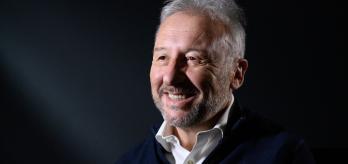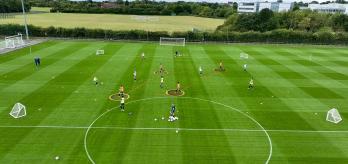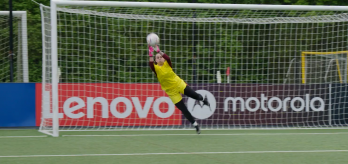Whilst we constantly monitor the current and developing trends across the game, we are also keen to assess future trends that may emerge. In order for things to change and evolve, the game needs innovators who are capable of conceptualising something different, i.e. something that has not been seen before.
Alberto Zaccheroni was a key member of the FIFA Technical Study Group that analysed the FIFA Club World Cup UAE 2021™. During his stint in the hotseat at Serie A outfit Udinese (1995-1998), Zaccheroni carved out a reputation as an innovator.
By way of example, his Udinese side found themselves down to ten men very early on in the league trip to Juventus in the 1996-97 season when one of his defenders received his marching orders with just three minutes on the clock. Having originally set his team up in a 4-4-2 system, the Italian made a bold yet considered decision to deviate from the 4-4-1 formation that would have been expected in such circumstances, instead opting to go with just three defenders in a 3-4-2 set-up.
Zaccheroni’s courage was rewarded as his side ran out 3-0 winners over the Vecchia Signora. He set his side up in a 3-4-3 formation in the team’s next outing, an away assignment at Parma Calcio, a contest that Udinese won 2-0. As a result of this, Zaccheroni is widely recognised as the godfather of the 3-4-3 blueprint that is commonly deployed in the modern game.
Thinking differently
Zaccheroni earned his status as an innovator because he thought differently to everyone else. He spotted that opposition teams struggled to play against his system because they had not seen it before and so did not know how to deal with it.
The Italian tactician was adamant that he had to play his most talented players and therefore sought to build his system around them.
"I can create balance, but ultimately your best players are your
match-winners. You need them out there on the pitch. I had three excellent forwards and wanted all of them to play. I didn’t ask my forwards to cover too much ground and didn’t want them to have to track back, which meant that they could play at a high tempo in the final third for the full 90 minutes."
This approach of relieving his forwards of some of their defensive duties meant that Zaccheroni had to take risks elsewhere on the pitch.
Out of possession
When his team came up against sides that adopted formations like the popular 4-4-2, he was happy to operate with just one spare defender up against the opposition's two strikers as it meant that he could field his three forwards.
When the opposition's defenders or central midfielders had the ball in central areas, Zaccheroni was keen for his four-man midfield to adopt a narrow set-up in front of his back three and position themselves in the central channel of the pitch, between the corner edges of the penalty box.
He wanted one of his central midfielders to press and for the other three midfielders to stay compact and narrow behind the player leading the press. This meant that when the ball was shifted across the pitch, the team could move with it, but the four midfield players had to do so as a unit. This was a crucial element within the system.
If the ball ended up in a wide area, the wide midfielder would lead the press, with the nearest central midfielder joining to provide support. The midfielders on the opposite flank would drop in to sit in front of the back three.
Zaccheroni insisted that his team press en masse and operate as a unit at all times. He was keen for his players to exert intense pressure on the opposition so as to prevent them from being able to switch the play with long balls or passes over the top to turn his defenders around.
When the opposition played the ball into the final third, a different approach was adopted.
If the ball went into a wide area 20-30 metres from his team's goal, the wide defender in the three-man backline was tasked with engaging the opposition. The central defender and the defender on the opposite flank would shift across, and the wide midfielder on the opposite wing was responsible for monitoring the number of opposition players in central attacking areas.
If there was only one striker in there with the two defenders, it was considered to be OK, but if there were two strikers, the midfielder on the opposite wing was asked to drop in to become the spare defender.
Zaccheroni revealed that he always preferred to accept managerial jobs that saw him appointed prior to the start of pre-season, given the time it took players to understand their roles and how to apply the principles involved in his strategies.
He initially set about coaching his system in small numbers and in unopposed exercises so as to allow the players to grasp and apply the theory. His sessions began with an unopposed back three and then progressed to an unopposed back three and midfield four, before moving on to a full-team shadow set-up.
Whilst the process took time, it was important for Zaccheroni that the players possessed a clear understanding of their roles in different scenarios.
He then progressed the sessions to include opposition, before overloading his defenders in set-ups that involved 3+4 with a goalkeeper v. 11 to develop the players' ability to operate, think and perform in chaotic and high-pressure situations.
"In our training sessions during the week, I worked with 3+4 against 11 and they hardly conceded any goals. They knew their roles. Then, when we won the ball back, we were able to attack with our three best attackers."
In possession
Zaccheroni was an attack-minded coach who was prepared to take calculated risks. During the build-up phase, he wanted to create overloads that the opposition's defenders had never previously faced so as to force new decisions on them.
In particular, Zaccheroni's teams targeted the opposition's full-backs.
When up against a back four, he played three forwards in a narrow set-up. The centre-forward operated in the space between the opposition's centre-back pairing, whilst the right- and left-hand forwards played on the inside, directly in front of the opposition's full-backs.
When the ball was in midfield, he wanted his nearest wide midfielder to push on and be level with the opposition's full-back, who was already tasked with marking one of the forwards in the narrow set-up, and his second central midfielder to advance centrally. In this set-up, the opposite wide midfielder would cover centrally as the screening defensive midfielder. He aimed to create overloads, particularly 2v1s against opposition full-backs and central midfielders.
In the first full season in which he deployed the system, the 1997-98 campaign, Zaccheroni was able to use his forward trident, formed by Oliver Bierhoff, Paolo Poggi and Márcio Amoroso dos Santos, to lethal effect. The German hitman netted 27 league goals in that season as Udinese finished third, behind champions Juventus and Inter Milan.
Changing the game
The evolution of technology and data in the modern game has seen the levels of analysis relating to the performance of both teams improve considerably.
Zaccheroni believes that it is becoming increasingly difficult for teams to produce something that is totally unexpected, but feels that what a coach does during the course of a match can ultimately have a greater impact.
"It’s very difficult to catch the opposition off guard nowadays because everyone knows everything about everyone. In modern football, you need to be able to change the game during the game; there's a greater emphasis on in-game management. The fact that you can now make five substitutions means you can completely change the game by changing almost half of your team."
However, he still feels that a coach's strategic approach to a game can have the same level of impact as their in-game changes.
Leading change
In order for any coach to become an innovator, they must be a leader who is capable of communicating their vision and convincing naysayers.
Doing things differently inevitably involves a certain element of unease, but an innovator needs to get their players and staff onside and help them to grow in order to add layers to their game. Creating initial buy-in is a crucial component of this process.
"Footballers aren't keen on innovation or new things. Experienced players like to do things the way they've always been done; they don't like new questions to be asked of them. My players didn't want to try the system and so I had to compromise, which I don't like doing, but I said to them: 'We’ll play the way we have when we're winning, but when we're losing, we're going to do things like this…"
"Eventually they came around and then after training, I could tell we were playing better, but they said 'No'. It was because we were winning, until we played away at Juventus, after 3 minutes, the referee sent one of my defenders off. We started the game in a 4-4-2 formation and so I switched to 3-4-2, I didn't take an attacker off and we won the game 3-0. Seven days later, we opened the title race right up by beating Parma and the players' eyes were wide with anticipation to see if we would go with a back three and they were relieved that I decided to do so. They were happy."
Zaccheroni’s philosophy and the success he enjoyed at Udinese earned him a move to AC Milan, where he guided the club to Scudetto glory in his maiden campaign.
Managing challenges
The evolution of the game on the pitch has been accompanied by a revolution off it. Boardrooms are now different environments and football clubs have been transformed from pillars of local communities to high-powered business entities. The rise of the media and social media means that players and coaches are exposed to a much greater volume of opinions and this creates a need for such external factors to be managed in a sensible way.
Things have changed massively since the 1990s. According to Zaccheroni, presidents were passionate, and the club was their hobby, but now clubs are under huge pressure to deliver results, both on and off the pitch. However, the Italian retains a strong belief that human relationships remain the cornerstone of any successful team.
"The focus of my attention is always on my players and staff. I’m not very political. My relationships are based on good manners, respect and values. They respect me and I respect them. I’m responsible for the final result, but I must also incorporate the results of everyone that makes up the team into that result."
Zaccheroni is also a big believer in protecting players in times of failure and giving them credit when success comes. That is how he goes about building another key component within his system: trust.
"My leadership style has never changed. My work with young players enabled me to develop and my style has always been based on mutual respect. Players realise that I’m responsible for the final result. I’m exposed to the public. I’m the one who puts my face forward and I never hang my players out to dry."
To innovate means to change. Doing things differently involves taking players out of their comfort zone and, as a result, the vision and communication from the head coach/manager are crucial to achieving buy-in and alignment amongst players and staff alike. In the mid-1990s, Zaccheroni sensed an opportunity to do something different and he most certainly made a difference.




















